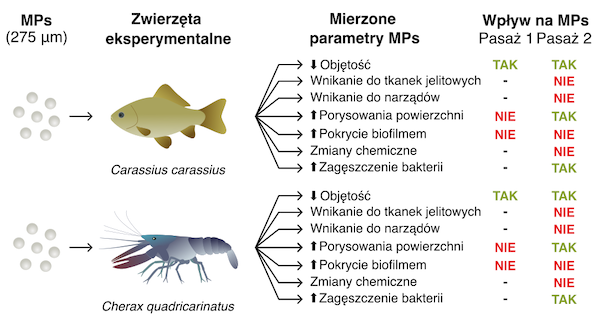A research team from the Faculty of Biology at the University of Warsaw has demonstrated that fish and large aquatic invertebrates contribute to the degradation of microplastics

19 03 2025
A research team from the Faculty of Biology at the University of Warsaw has demonstrated that the foraging activity of fish and large aquatic invertebrates, such as crayfish, contributes to the mechanical fragmentation of microplastics, reducing their average size and accelerating their degradation.
This discovery is detailed in the article „Microplastic Passage through the Fish and Crayfish Digestive Tract Alters Particle Surface Properties” published in Environmental Science and Technology. The research team includes Ewa Babkiewicz, Julita Nowakowska, Marcin Żebrowski, Katarzyna Jarosińska, and Piotr Maszczyk.
The researchers conducted an experiment analyzing how microplastics passing through the digestive tracts of cyprinid fish (Carassius carassius) and crayfish (Cherax quadricarinatus) impact particle surface properties, size, and bacterial colonization.
The animals were fed a diet either with or without microplastics. After passing through the digestive tract twice, the particles were exposed to known bacterial concentrations. Surface damage, particle size changes, and biofilm formation were analyzed using scanning electron microscopy (SEM), while surface chemical composition was assessed with Fourier-transform infrared spectroscopy (FTIR). Additionally, nanoplastic penetration into digestive tract tissues was examined using pyrolysis–gas chromatography–mass spectrometry (Py-GC/MS).
The results indicate that passage through the digestive tract alters the surface properties of microplastics and leads to their fragmentation, without affecting their chemical composition or the penetration of nanoplastics into animal tissues. The data suggest that the feeding activity of fish and crayfish plays a significant role in the degradation of microplastics in aquatic environments, facilitating their breakdown and promoting further biodegradation by microorganisms.
These findings highlight the necessity of considering the role of aquatic organisms in modeling the plastic cycle in ecosystems, which can aid in better predicting the fate of microplastics and developing more effective strategies to reduce plastic pollution.